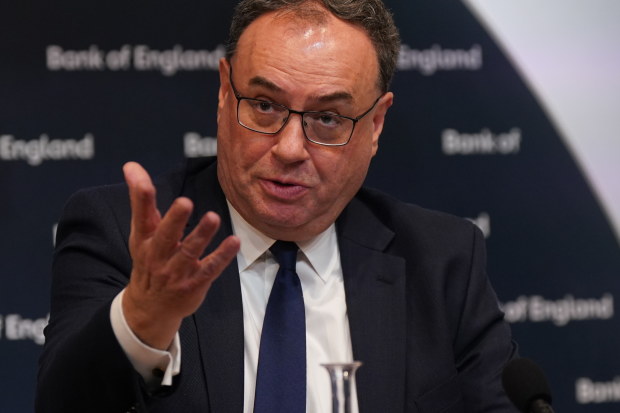UK inflation slows more than forecast, fuelling rate-cut bets
UK inflation slowed far more than economists forecast in November, a surprise that prompted traders to boost bets the Bank of England will soon have to abandon its higher-for-longer narrative on interest rates.
Consumer prices rose 3.9 per cent from a year earlier, down from 4.6 per cent in October, according to data released by the Office for National Statistics on Wednesday (Thursday AEDT). The slowdown was much sharper than the 4.3 per cent economists had expected. None had predicted prices rising by less than 4.2 per cent.

The data come less than a week after BOE governor Andrew Bailey made his latest attempt to push back against market expectations for a pivot toward easing. Getty
Traders responded by ramping up bets on BoE interest rate cuts next year to as much as 145 basis points, the most in the current cycle. That means five quarter-point cuts are fully priced. The 10-year gilt yield fell as much as 11 basis points to 3.54 per cent. The pound extended losses, falling as much as 0.6 per cent to $US1.2658, while UK stocks surged, led by home builders.
It marked the first time food price inflation, one of the biggest drivers of Britain’s cost-of-living crisis, has been in single digits since June last year. Motor vehicle fuel prices also contributed to the slowdown. Services inflation, which the BoE has repeatedly cited as a persistent source of price-pressure concern, dropped to the lowest since January.
The results represented the third downward surprise in the past four months and the biggest since inflation concerns took hold in 2021. Consumer prices fell 0.2 per cent between October and November, the biggest decline for the month since 2014.
The data come less than a week after BoE governor Andrew Bailey made his latest attempt to push back against market expectations for a pivot towards easing. Mr Bailey said “there is still some way to go” in the fight against inflation last Thursday, after the bank’s Monetary Policy Committee voted to leave rates at a 15-year high for their third-straight meeting.
“The surprisingly low reading in today’s UK CPI figures is questioning last week’s impression after the MPC meeting that the UK might be one of the slow movers when it comes to rate cuts in 2024 and beyond,” said Ulrich Leuchtmann, head of FX research at Commerzbank in Frankfurt.
Good news for PM
The figures give Prime Minister Rishi Sunak a bright spot to focus on as he heads into an election year trailing the opposition Labour Party by about 20 percentage points in public opinion polls. Mr Sunak had begun the year vowing to halve the rate of inflation, which was then running at more than 10 per cent.
“With inflation more than halved we are starting to remove inflationary pressures from the economy,” Chancellor of the Exchequer Jeremy Hunt said. He said budget policies announced last month would help spur growth. “Alongside the business tax cuts announced in the autumn statement, this means we are back on the path to healthy, sustainable growth.”
Underlying measures of prices being watched closely by the BoE for signs of persistent inflation also cooled more than expected. Core inflation – which strips out volatile food and energy costs – eased to 5.1 per cent from 5.7 per cent, while services inflation fell to 6.3 per cent, down from 6.6 per cent. Services prices are being monitored by the BoE for signs that the tight labour market is still fuelling wages and feeding into prices.
“This startling fall in inflation will further reassure people and businesses that there is light at the end of the tunnel in the struggle against eye-watering price rises,” said Suren Thiru, economics director at accountancy trade body the ICAEW. “These inflation numbers suggest that the Bank of England is too pessimistic in its rhetoric over when interest rates could start falling.”
Inflation is still almost double the BoE’s 2 per cent target and higher than the US and the eurozone. “Inflation eased again to its lowest annual rate for over two years, but prices remain substantially above what they were before the invasion of Ukraine,” ONS chief economist Grant Fitzner said on Wednesday.
Food prices rose 9.2 per cent from a year earlier, down from 10.1 per cent in October. Motor vehicle fuel prices were down 10.6 per cent after dropping 2.4 per cent on the month.
Prices of recreational and cultural goods and services were also driving down inflation, sliding 0.4 per cent between October and November. The largest downward contributions came from games, toys and hobbies – particularly computer games – and cultural services, especially admission fees to theatres and live music events.
The fall in producer prices, which often signal costs coming down the pipeline for consumers, was smaller than predicted. Factory gate prices dropped 0.2 per cent compared to a year earlier, below the 0.5 per cent slump predicted by economists. The 2.6 per cent tumble in input costs that producers pay for raw materials and fuel was unchanged from the previous month.
“The most important detail is in the services measure,” Ana Andrade, of Bloomberg Economics, told Bloomberg Television. “This data print definitely increased the chances of an earlier cut.”
Bloomberg
Introducing your Newsfeed
Follow the topics, people and companies that matter to you.
Find out moreRead More
Latest In Economy
Fetching latest articles